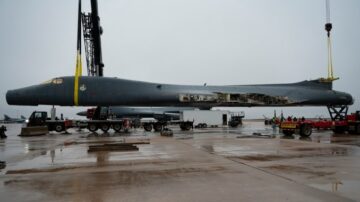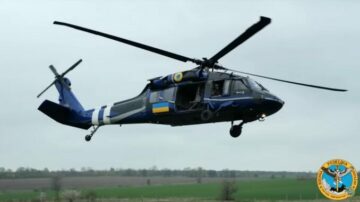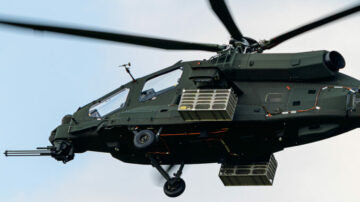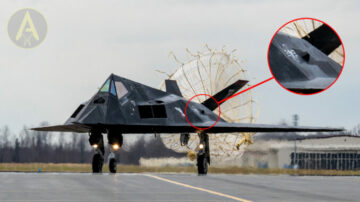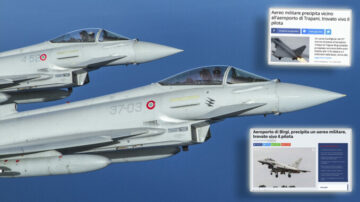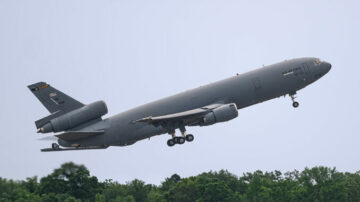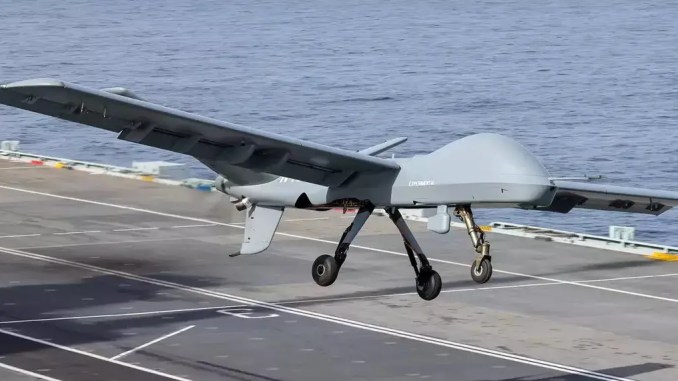
The Short Take Off and Landing derivative of the MQ-1C Gray Eagle is being used to test new unmanned capabilities that the Royal Navy wants to introduce on its aircraft carriers.
The HMS Prince of Wales aircraft carrier reached another milestone as it is underway off the United States’ coasts for the Westlant 23 campaign. In fact, after completing the developmental test phase 3 (DT-3) sea trials with the F-35B Lightning II, the newest aircraft carrier of the Royal Navy tested on Nov.15, 2023, the new Mojave Remotely Piloted Aircraft System, largest unmanned aircraft ever launched from a British ship.
In fact, no uncrewed machine the size of Mojave – nine metres long, with a wingspan of 17 metres (six metres wider than an F-35B) and weighing more than one and a half tonnes fully loaded – has ever flown from an aircraft carrier outside the US Navy. Although this isn’t the first fixed wing UAS test on a British aircraft carrier, the systems tested before were much smaller and lighter.
“The Mojave trial is a European first – the first time that a Remotely Piloted Air System of this size has operated to and from an aircraft carrier outside of the United States,” said the planner of Mojave’s test, Rear Adm. James Parkin, Royal Navy Director Develop. “The success of this trial heralds a new dawn in how we conduct maritime aviation and is another exciting step in the evolution of the Royal Navy’s carrier strike group into a mixed crewed and uncrewed fighting force.“
The future is here!!! pic.twitter.com/m8qw1xQN64
— HMS Prince of Wales (@HMSPWLS) November 17, 2023
The Mojave is a Short Take Off and Landing (STOL) Medium Altitude Long Endurance (MALE) RPAS that General Atomics developed from the MQ-1C Gray Eagle-Extended Range. The objective was to create a drone suited for expeditionary operations from forward-bases without the need for typical paved runways or infrastructure.
Like the Gray Eagle ER, Mojave can be equipped with a sensor suite including EO/IR, Synthetic Aperture Radar/Ground Moving Target Indicator (SAR/GMTI) and Signal Intelligence (SIGINT) to support land or maritime missions. However, its payload is doubled compared to the Gray Eagle as its increased wing surface area allows it to carry up to 3,600 lb (1,633 kg), which totals as many as 16 AGM-114 Hellfire missiles.
A similar STOL wing set option is planned for the larger MQ-9B aircraft family, which also includes the new Protector RG Mk 1 currently being delivered to the Royal Air Force. The MQ-9B version, called MQ-9B STOL, is being considered by the Royal Navy and other navies that operate aircraft from large flat-deck warships without catapults and arresting gear.
Mojave prepares to approach the HMS Prince of Wales during the test. (Photo: General Atomics)
” data-medium-file=”https://i0.wp.com/theaviationist.com/wp-content/uploads/2023/11/Mojave_RPAS_HMS_Prince_of_Wales_2.jpg?fit=460%2C259&ssl=1″ data-large-file=”https://i0.wp.com/theaviationist.com/wp-content/uploads/2023/11/Mojave_RPAS_HMS_Prince_of_Wales_2.jpg?fit=706%2C397&ssl=1″ decoding=”async” class=”size-large wp-image-84129″ src=”https://platoaistream.net/wp-content/uploads/2023/11/mojave-rpas-flies-from-hms-prince-of-wales-aircraft-carrier-1.jpg” alt width=”706″ height=”397″ srcset=”https://platoaistream.net/wp-content/uploads/2023/11/mojave-rpas-flies-from-hms-prince-of-wales-aircraft-carrier-1.jpg 706w, https://platoaistream.net/wp-content/uploads/2023/11/mojave-rpas-flies-from-hms-prince-of-wales-aircraft-carrier-5.jpg 460w, https://platoaistream.net/wp-content/uploads/2023/11/mojave-rpas-flies-from-hms-prince-of-wales-aircraft-carrier-6.jpg 128w, https://platoaistream.net/wp-content/uploads/2023/11/mojave-rpas-flies-from-hms-prince-of-wales-aircraft-carrier-7.jpg 768w, https://platoaistream.net/wp-content/uploads/2023/11/mojave-rpas-flies-from-hms-prince-of-wales-aircraft-carrier-8.jpg 678w, https://i0.wp.com/theaviationist.com/wp-content/uploads/2023/11/Mojave_RPAS_HMS_Prince_of_Wales_2.jpg?w=1024&ssl=1 1024w” sizes=”(max-width: 706px) 100vw, 706px” data-recalc-dims=”1″>
The takeoff of Mojave, which was controlled by a crew from a control station onboard the ship, was performed at an angle, without using the ski jump normally used by the F-35B. The demonstration included takeoff, circuits around the ship and approaches, ending with a landing back onto the carrier without using any form of arrestor gear.
“My team and I are excited and proud to be the first to launch and land a Mojave from an aircraft carrier,” said Commander Martin Russell, in charge of air operations aboard HMS Prince of Wales. “During a deployment centred around experimentation and expanding the envelope of the Queen Elizabeth class, this is one of the highlights. Integrating the Navy Develop and General Atomics personnel into the Prince of Wales team was key to enabling such a large Remotely Piloted Air System to operate from the deck during this trial, with the capability feeling like a glimpse into the future of these ships.”
While the Royal Navy did not mention any plans to acquire the Mojave, this testing falls under the long-term Future Maritime Aviation Force project for 2030. The service is, in fact, working on multiple unmanned aircraft projects that will be increasingly teamed with manned aircraft and act as force multipliers while also creating mass for the carrier air wing.
.@RoyalNavy briefing on future unmanned rotary capabilities at #IMHelicon, but note the carrier landing MQ-28 Ghost Bat… #drone #drones pic.twitter.com/RQhjMAzNRx
— Gareth Jennings (@GarethJennings3) February 21, 2023
“With so many international partners interested in the results of these Mojave trials on board HMS Prince of Wales, I am delighted that we are taking the lead in such exciting and important work to unlock the longer-term potential of the aircraft carrier and push it deep into the 21st Century as a highly potent striking capability.” said the Royal Navy’s Second Sea Lord, Vice Admiral Martin Connell, adding that embracing autonomy was “the next logical step to ensuring that the Royal Navy can continue to fight and win in an increasingly-complex operating environment”.
At least five unmanned aircraft were disclosed so far. A multirole high-performance drone, called Vixen, capable of carrying two 500kg modular payloads to support Persistent Wide Area Surveillance, Electronic Warfare and armed strike missions in currently in the works. Royal Navy’s briefing showed as placeholder for Vixen an MQ-28 Ghost Bat, modified with the addition of an arrestor hook. Its size would require the use of catapults for the launch.
The second fixed wing drone in the works is Vampire, a small and relatively simple design that the Royal Navy plans to use initially as an adversary emulator for air defence training purposes. The aircraft, based on the Qinetiq Banshee target drone, can be launched from ashore or by using ramps from carrier deck and then recovered after a parachute landing.
Infographic for Mojave. (Image: General Atomics)
” data-medium-file=”https://i0.wp.com/theaviationist.com/wp-content/uploads/2023/11/Mojave_RPAS_HMS_Prince_of_Wales_3.jpg?fit=393%2C460&ssl=1″ data-large-file=”https://i0.wp.com/theaviationist.com/wp-content/uploads/2023/11/Mojave_RPAS_HMS_Prince_of_Wales_3.jpg?fit=706%2C826&ssl=1″ decoding=”async” loading=”lazy” class=”size-large wp-image-84126″ src=”https://platoaistream.net/wp-content/uploads/2023/11/mojave-rpas-flies-from-hms-prince-of-wales-aircraft-carrier-2.jpg” alt width=”706″ height=”826″ srcset=”https://platoaistream.net/wp-content/uploads/2023/11/mojave-rpas-flies-from-hms-prince-of-wales-aircraft-carrier-2.jpg 706w, https://platoaistream.net/wp-content/uploads/2023/11/mojave-rpas-flies-from-hms-prince-of-wales-aircraft-carrier-9.jpg 393w, https://platoaistream.net/wp-content/uploads/2023/11/mojave-rpas-flies-from-hms-prince-of-wales-aircraft-carrier-10.jpg 82w, https://platoaistream.net/wp-content/uploads/2023/11/mojave-rpas-flies-from-hms-prince-of-wales-aircraft-carrier-11.jpg 768w, https://i0.wp.com/theaviationist.com/wp-content/uploads/2023/11/Mojave_RPAS_HMS_Prince_of_Wales_3.jpg?w=1024&ssl=1 1024w” sizes=”(max-width: 706px) 100vw, 706px” data-recalc-dims=”1″>
The other designs currently disclosed are rotary wing aircraft, starting from Proteus. This UAS, showed as a tandem twin rotor, is already in development with Leonardo and a demonstrator could possibly fly in 2025. Similarly to Vixen, Proteus will carry two 500kg modular payloads and complement the Merlin HM2 helicopters, as the plans envision a 4-phase spiral development from Maritime Intra-Theatre Lift (MITL) to Anti-Submarine Warfare (ASW), Intelligence, Surveillance and Reconnaissance (ISR) roles and ultimately he capability to employ lightweight torpedoes.
Peregrine might become the first of these systems to become operational, as it could enter service as soon as 2024. For this project, the Royal Navy selected the Schiebel S-100 Camcopter equipped with Thales I-Master airborne surveillance radar that offers ultra-fine Synthetic Aperture Radar (SAR) imagery, Maritime Moving Target Indication (MMTI) and Ground Moving Target Indication (GMTI) modes. Its role, as it can be deducted by the equipment, will be ISR.
A more conventional quadcopter design has ben chosen for Panther, a logistical UAS for ship-to-ship and ship-to-shore, beyond visual line-of-sight resupply operations. Several tests have already been performed this year with multiple designs.
General Atomics Mojave drone (N450MV) on deck of HMS Prince of Wales (Photo: Royal Navy)
” data-medium-file=”https://i0.wp.com/theaviationist.com/wp-content/uploads/2023/11/Mojave_RPAS_HMS_Prince_of_Wales_4.jpg?fit=460%2C259&ssl=1″ data-large-file=”https://i0.wp.com/theaviationist.com/wp-content/uploads/2023/11/Mojave_RPAS_HMS_Prince_of_Wales_4.jpg?fit=706%2C397&ssl=1″ decoding=”async” loading=”lazy” class=”size-large wp-image-84127″ src=”https://platoaistream.net/wp-content/uploads/2023/11/mojave-rpas-flies-from-hms-prince-of-wales-aircraft-carrier-3.jpg” alt width=”706″ height=”397″ srcset=”https://platoaistream.net/wp-content/uploads/2023/11/mojave-rpas-flies-from-hms-prince-of-wales-aircraft-carrier-3.jpg 706w, https://platoaistream.net/wp-content/uploads/2023/11/mojave-rpas-flies-from-hms-prince-of-wales-aircraft-carrier-12.jpg 460w, https://platoaistream.net/wp-content/uploads/2023/11/mojave-rpas-flies-from-hms-prince-of-wales-aircraft-carrier-13.jpg 128w, https://platoaistream.net/wp-content/uploads/2023/11/mojave-rpas-flies-from-hms-prince-of-wales-aircraft-carrier-14.jpg 768w, https://platoaistream.net/wp-content/uploads/2023/11/mojave-rpas-flies-from-hms-prince-of-wales-aircraft-carrier-15.jpg 678w, https://i0.wp.com/theaviationist.com/wp-content/uploads/2023/11/Mojave_RPAS_HMS_Prince_of_Wales_4.jpg?w=1024&ssl=1 1024w” sizes=”(max-width: 706px) 100vw, 706px” data-recalc-dims=”1″>
To be able to support these UAS, the Royal Navy initiated project Ark Royal, which could possibly involve modifying the flight deck of the Queen Elizabeth class carriers to support STOBAR (Short Take-Off But Arrested Recovery) and CATOBAR (Catapult Assisted Take Off Barrier Arrested Recovery) operations. This kind of modifications was already proposed in the past when the service was still evaluating a possible acquisition of the F-35C, but the plans were later abandoned.
In fact, unlike the CATOBAR design of US carriers, the Queen Elizabeth class aircraft carriers were built in the STOVL (Short Take-off Vertical Landing) configuration where, instead of a catapult at the bow of the ship, a 12.5° / 60m ramp (often referred to as a ski jump) is installed. This, in combination with the lack of arresting wires at the stern of the ship mean that only aircraft with STOVL capabilities such as the F-35B and AV-8B Harriers can operate on such ships. The trade of a ski jump over a catapult means less stress posed to the operating aircraft on take-off, but also results in lower take-off speeds and max take-off weight.
This design constraint limits the types of aircraft capable of operating on the Queen Elizabeth class carriers. In the past, some argued that the British aircraft carriers lack dedicated refueling, ISR and Airborne Early Warning platforms that are currently available only in CATOBAR configuration (such as the E-2D Hawkeye), having to rely only on Merlin HM2 helicopters converted to the AEW variant with the Crowsnest kit. The testing of Mojave proved that the current gap in ISR capabilities could potentially be remedied by utilizing UAS platforms as envisioned in the Future Maritime Aviation Force project for 2030.
A presentation from Defence Leaders’ Combined Naval Event 2023 showing possible modifications for the Royal Navy’s aircraft carriers. (Image: Royal Navy)
” data-medium-file=”https://i0.wp.com/theaviationist.com/wp-content/uploads/2023/11/Mojave_RPAS_HMS_Prince_of_Wales_5.jpg?fit=460%2C406&ssl=1″ data-large-file=”https://i0.wp.com/theaviationist.com/wp-content/uploads/2023/11/Mojave_RPAS_HMS_Prince_of_Wales_5.jpg?fit=706%2C623&ssl=1″ decoding=”async” loading=”lazy” class=”size-large wp-image-84128″ src=”https://platoaistream.net/wp-content/uploads/2023/11/mojave-rpas-flies-from-hms-prince-of-wales-aircraft-carrier-4.jpg” alt width=”706″ height=”623″ srcset=”https://platoaistream.net/wp-content/uploads/2023/11/mojave-rpas-flies-from-hms-prince-of-wales-aircraft-carrier-4.jpg 706w, https://platoaistream.net/wp-content/uploads/2023/11/mojave-rpas-flies-from-hms-prince-of-wales-aircraft-carrier-16.jpg 460w, https://platoaistream.net/wp-content/uploads/2023/11/mojave-rpas-flies-from-hms-prince-of-wales-aircraft-carrier-17.jpg 109w, https://platoaistream.net/wp-content/uploads/2023/11/mojave-rpas-flies-from-hms-prince-of-wales-aircraft-carrier-18.jpg 768w, https://i0.wp.com/theaviationist.com/wp-content/uploads/2023/11/Mojave_RPAS_HMS_Prince_of_Wales_5.jpg?w=1024&ssl=1 1024w” sizes=”(max-width: 706px) 100vw, 706px” data-recalc-dims=”1″>
Drawings published online show the addition of an angled deck to deconflict the use of UAS with the F-35 operations, as well as two catapults (possibly EMALS) and arrestor cables. Speaking at the Defence Leaders’ Combined Naval Event 2023 conference earlier this year, Col. Phil Kelly, the head of carrier strike and maritime aviation at the Royal Navy’s Develop Directorate, said the service is exploring options for the phased introduction of aircraft launch and recovery equipment to enable the operation of high-performance uncrewed strike and support systems, and potentially fixed-wing crewed aircraft.
- SEO Powered Content & PR Distribution. Get Amplified Today.
- PlatoData.Network Vertical Generative Ai. Empower Yourself. Access Here.
- PlatoAiStream. Web3 Intelligence. Knowledge Amplified. Access Here.
- PlatoESG. Carbon, CleanTech, Energy, Environment, Solar, Waste Management. Access Here.
- PlatoHealth. Biotech and Clinical Trials Intelligence. Access Here.
- Source: https://theaviationist.com/2023/11/21/mojave-rpas-hms-pow/?utm_source=rss&utm_medium=rss&utm_campaign=mojave-rpas-hms-pow
- :has
- :is
- :not
- :where
- $UP
- 1
- 12
- 125
- 15%
- 16
- 17
- 2023
- 2024
- 2025
- 2030
- 21st
- 23
- 60m
- a
- Able
- Achieve
- acquire
- acquisition
- Act
- adding
- addition
- Aerospace
- aerospace engineering
- After
- AIR
- Air Force
- aircraft
- allows
- already
- also
- Although
- am
- among
- an
- and
- Another
- any
- applied
- approach
- approaches
- ARE
- AREA
- areas
- argued
- Ark
- armed
- Army
- around
- arrested
- AS
- assisted
- At
- Autonomy
- available
- avatar
- aviation
- back
- barrier
- based
- BE
- become
- been
- before
- being
- ben
- Beyond
- board
- Briefing
- British
- built
- but
- by
- cables
- called
- Campaign
- CAN
- capabilities
- capability
- capable
- carriers
- carry
- carrying
- centre
- Century
- charge
- chosen
- class
- combination
- combined
- compared
- Complement
- completing
- Conduct
- Conference
- Configuration
- conflicts
- considered
- continue
- contributor
- control
- controlled
- conventional
- converted
- could
- create
- Creating
- crew
- Current
- Currently
- deck
- dedicated
- deep
- defence
- Degree
- delighted
- delivered
- deployment
- derivative
- Design
- designs
- develop
- developed
- Development
- developmental
- DID
- direction
- Director
- drone
- during
- Earlier
- Early
- Electronic
- embracing
- enable
- enabling
- end
- ending
- Engineering
- ensuring
- Enter
- envision
- envisioned
- equipment
- equipped
- Ether (ETH)
- European
- evaluating
- Event
- EVER
- evolution
- excited
- exciting
- expanding
- expertise
- Exploring
- fact
- Falls
- family
- far
- fight
- fighting
- Fire
- First
- first time
- five
- fixed
- flight
- For
- Force
- form
- Former
- freelance
- from
- fully
- future
- gap
- Gear
- General
- Ghost
- Glimpse
- graduate
- gray
- Ground
- Group
- Half
- Have
- having
- he
- head
- helicopters
- heralds
- high-performance
- highlights
- highly
- his
- How
- However
- HTTPS
- i
- image
- important
- in
- included
- includes
- Including
- increased
- increasingly
- indication
- Indicator
- Infrastructure
- initially
- initiated
- installed
- instead
- Integrating
- Intelligence
- interest
- interested
- International
- into
- introduce
- Introduction
- involve
- IT
- Italy
- ITS
- james
- jennings
- journalist
- jpg
- jump
- Keen
- Key
- Kind
- Kingdom
- korea
- Lack
- Land
- landing
- large
- larger
- largest
- later
- launch
- launched
- lead
- least
- less
- lighter
- lightning
- lightweight
- like
- limits
- logical
- London
- Long
- long-term
- lower
- machine
- many
- Maritime
- Martin
- Mass
- master
- max
- max-width
- mean
- means
- medium
- mention
- merlin
- might
- milestone
- Military
- missiles
- missions
- mixed
- modes
- Modifications
- modified
- modular
- more
- moving
- much
- multiple
- Need
- New
- Newest
- next
- nine
- no
- normally
- note
- nov
- objective
- of
- off
- Offers
- on
- Onboard
- ONE
- online
- only
- onto
- operate
- operated
- operating
- operation
- operational
- Operations
- operator
- Option
- Options
- or
- osint
- Other
- outside
- over
- partners
- past
- paved
- performed
- Personnel
- phase
- Phased
- PHIL
- photo
- piloted
- placeholder
- plane
- planned
- plans
- Platforms
- plato
- Plato Data Intelligence
- PlatoData
- posed
- possible
- possibly
- potent
- potential
- potentially
- Prepares
- presentation
- Prince
- project
- projects
- proposed
- proud
- proved
- published
- purposes
- Push
- queen
- Queen Elizabeth
- radar
- Radio
- Ramp
- Ramps
- reached
- recovery
- referred
- Refueling
- relatively
- rely
- remotely
- Republic
- require
- Results
- Role
- roles
- royal
- s
- Said
- SEA
- Second
- selected
- served
- service
- set
- several
- ships
- Short
- show
- showed
- showing
- Signal
- similar
- Similarly
- Simple
- SIX
- Size
- small
- smaller
- So
- so Far
- some
- Soon
- speaking
- speeds
- spotting
- Starting
- States
- station
- Step
- Still
- stress
- strike
- Student
- Studying
- success
- such
- suite
- support
- Surface
- surveillance
- synthetic
- system
- Systems
- Take
- takes
- taking
- Tandem
- Target
- team
- teamed
- techniques
- test
- tested
- Testing
- tests
- than
- that
- The
- The Future
- the world
- then
- These
- this
- this year
- time
- to
- trade
- Training
- trial
- trials
- twin
- two
- types
- typical
- Ultimately
- under
- Underway
- United
- United Kingdom
- United States
- unlike
- unlock
- us
- use
- used
- using
- Utilizing
- Vampire
- Variant
- vehicle
- version
- vertical
- vice
- visual
- wants
- warning
- was
- we
- weighing
- weight
- WELL
- were
- when
- which
- while
- wide
- wider
- will
- win
- Wing
- with
- without
- Work
- working
- works
- world
- would
- year
- zephyrnet



